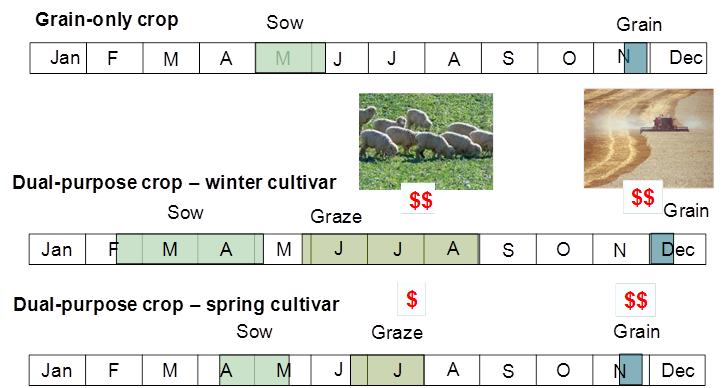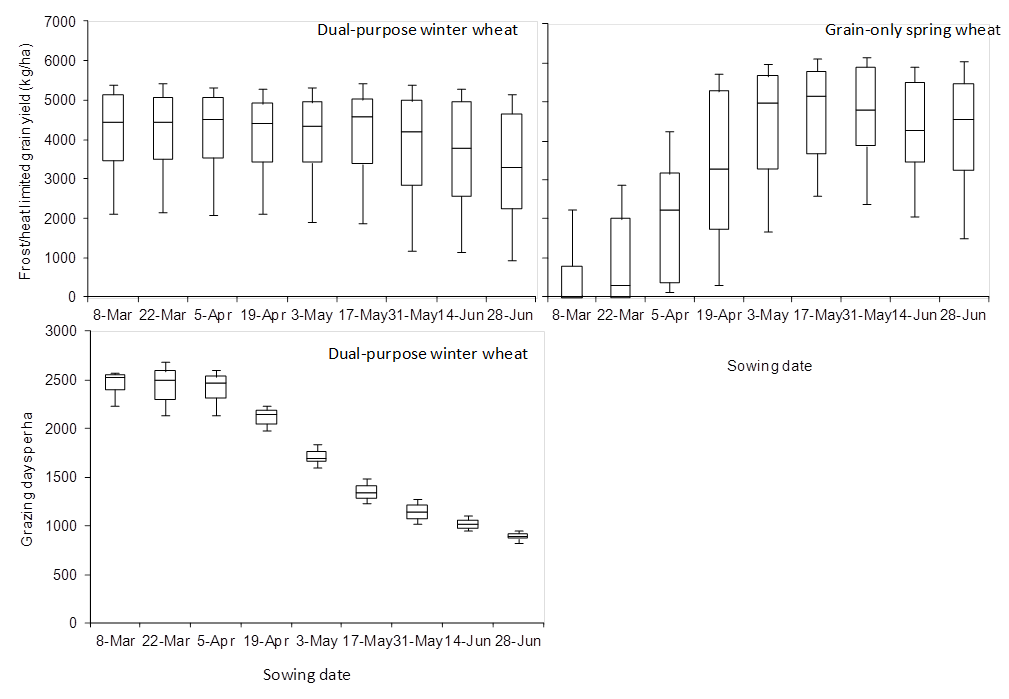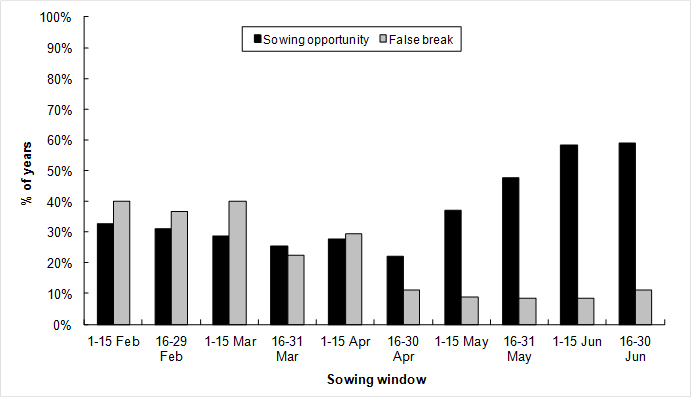Dual purpose crops: economics and their management
Author: Dr Lindsay Bell, CSIRO | Date: 25 Jul 2014
Take home messages
- Dual-purpose crops can provide flexibility in sowing time, forage at a key time of the year and in some cases can increase returns from crops.
- Frequent early sowing opportunities provide potential to use long-season dual-purpose varieties which can provide up to 2000 DSE grazing days/ha in autumn and early winter and achieve similar grain yields to traditional grain-only systems.
- Typical ‘grain-only’ spring cultivars can be grazed without greatly reducing grain yield – though grazing provided is much less than from early sown dual-purpose varieties.
- Early sown canola can also be grazed but later sown crops are likely to suffer larger yield penalties unless grazing pressure is reduced.
Introduction
The success of dual-purpose cereals and canola in southern Australia has prompted interest in the opportunities to expand this practice into the northern crop-livestock region (i.e. northern NSW and southern Queensland). While small areas of dual-purpose crops are currently sown in some areas our research is showing there is significant wider potential offered by dual-purpose crops. Grazing of grain crops could offer opportunities to:
- capitalise on early sowing opportunities (e.g. March to April) by sowing longer season varieties
- use grazing to manipulate phenology to ensure flowering remains in the appropriate window and/or manage crop canopy to slow early season crop water use and ensure more water is available for the vital grain filling period;
- to replace or complement forage-only crops (e.g. oats) to provide high value feed during June – August, when pasture growth and quality is often low.

Figure 1. Calender of events for dual-purpose grain-grazing use of winter and spring crops.
Figure 1 depicts the key differences between dual-purpose crops and grain-only crops.
- Long-season winter cultivars ,which require a period of vernalisation before they commence reproductive growth can be sown much earlier than traditional grain-only crops, allowing a long period of grazing and later be locked up to produce grain yield.
- Spring cultivars too can be sown a few weeks earlier than traditional grain-only crops, thereby providing a period of grazing though this is shorter than from the winter types.
How much grazing and grain yield can be obtained from dual-purpose cereals compared to grain-only?
Figure 2 shows simulated grain yields from a dual-purpose winter wheat cultivar are stable through early sowing windows from early March until mid May; vernalisation requirements slow development allowing the crop to avoid the high frost period. By comparison, early sowing of spring wheats would typically expose these crops to a high frost risk and hence achieve highly variable and low grain yields if sown too early. The early sown winter wheats can provide >2000 DSE grazing days/ha (i.e. 80 days of 25 sheep/ha) in addition to similar grain yields to grain-only spring cultivars sown later. These simulations suggest that dual-purpose winter wheat cultivars could provide an option to capitalise on early sowing opportunities.

Figure 2. Simulated grain yield and grazing potential from a dual-purpose winter wheat compared with a grain-only spring wheat sown at fortnightly intervals in northern NSW
Figure 3 also demonstrates that sowing opportunities in any fortnighly period from early Feburary to mid-April can occur in 25% of years on the northern slopes. Hence there are regular opportunities which could enable early sowing of long-season dual-purpose crops. However, there is a higher risk that these crops would not recieve follow-up rain than crops sown from May onwards.

Figure 3. Frequency of sowing opportunities (rain over 7 days>evaporation over 7 days) in fortnightly windows at Warialda from historical climate records. False break is the % of sowing opportunities not followed by further effective rain in the subsequent 6 weeks.
Field experiments conducted in northern NSW support the results from simulation modelling. Table 1 compares the grain yields from a typical sowing date for grain-only spring cultivars with a range of grazed and ungrazed early sown winter and spring cereal varieties. Early sown long-season dual-purpose cereals (e.g. Mackellar, Wedgetail, Urambie and Tobruk), compared to shorter-season varieties sown in their typical window had similar or higher yield potentials even after grazing (shown in bold). About 1 to 1.5 t/ha of biomass was grazed from these varieties in late June. While larger than expected yield penalties were observed in this experiment, the value of this grazing was sufficient to compensate for these yield losses and can increase net crop returns compared to traditional grain-only systems. This benefit would be further enhanced should grazing management be refined to reduce yield penalties in the northern region – in southern regions crops can recover following grazing to produce grain yields equivalent of un-grazed crops.
Table 1. Grain yield and biomass grazed for cereal cultivars at Warialda in 2011. Yield and revenue outcomes for grain-only strategy for two benchmark grain-only varieties are shown in bold.
Sowing date/Variety | Graze Stage | Grain yield (t/ha) | Biomass grazed (t/ha) | Net returns ($/ha)* | ||||
Grain-only | Grazed | Change | Grain-only | Grazed | ||||
22 May | Gregory | 4.9 | 1225 | |||||
Sunbrook | 5.6 | 1400 | ||||||
7 Apr (Early) | Mackellar | V | 6.8 | 5.2 | -1.6 | 1.40 | 1496 | 1536 |
Wedgetail | Z31 | 5.0 | 4.5 | -0.5 | 0.35 | 1250 | 1223 | |
Sunbrook | Z33 | 5.3 | 2.7 | -1.6 | 1.04 | 1325 | 966 | |
Gregory | Z41 | 4.3 | 3.8 | -0.5 | 0.35 | 1075 | 1048 | |
Kennedy | Z44 | 2.8 | 3.2 | +0.5 | 0.34 | 700 | 895 | |
Urambie | V | 4.4 | 3.0 | -1.4 | 0.71 | 968 | 860 | |
Sheppard | Z55 | 2.6 | 2.4 | -0.2 | 0.95 | 572 | 794 | |
Tobruk | V | 6.4 | 5.3 | -1.1 | 0.91 | 1408 | 1420 | |
*Economic assumptions were: Hard wheat = $250/t, Feed & barley = $220/t, biomass grazed = $0.28/kg or $280/t.
Early sown short-season cultivars (e.g. Kennedy and Sheppard barley) suffered significant yield penalties from early sowing, but grazed crops yielded similar to ungrazed crops, even though grazing occurred after the ‘safe’ phenological window (GS 30). This is attributed to a phenological delay caused by grazing which reduced the impact of frost on grain yield.
Is there potential to graze short or mid-season spring cereals?
While early sown long-season dual-purpose cultivars can provide large amounts of grazing, there is significant potential to also utilise early biomass from later sown crops intended for grain-only production. On-farm demonstrations at 10 sites in farmer’s cereal crops sown under ‘normal’ management were defoliated before stem elongation in 2012 (Table 2). At this time around 1 t/ha of biomass was available from wheat crops and barley crops provided more than 1.5-2.5 t/ha. At seven of the 10 sites, yield penalties were small (<0.2 t/ha) or even yield increases were observed, while at 3 locations yield penalties were > 0.6t/ha. However, at all locations the grazing value provided by these crops was sufficient to offset any yield reductions. The sites with large yield penalties did not achieve any significant gain in returns (<$70/ha), but at the other sites net returns from the crop could be increased by up to $450/ha. This analysis also suggested that barley crops were the most likely to provide increases in net returns from grazing because of their superior early biomass production.
Table 2. Biomass available for grazing from ‘typical’ cereal crops and yield following cutting compared to uncut control at 10 sites in the Warialda-Delungra district during 2012.
Crop | Biomass removed (t/ha) | ‘Grazed’ yield (t/ha) | ‘Ungrazed’ yield (t/ha) | Effect on grain yield (t/ha) | Grazed vs ungrazed crop returns ($/ha)* |
Barley | 2.6 | 3.5 | 3.4 | +0.1 | +460 |
Barley | 1.6 | 2.8 | 3.1 | -0.3 | +200 |
Wheat | 1.1 | 3.9 | 3.5 | +0.4 | +273 |
Wheat | 1.1 | 2.4 | 2.6 | -0.2 | +140 |
Wheat | 1.0 | 3.4 | 3.7 | -0.3 | +100 |
Wheat | 0.5 | 2.7 | 2.5 | +0.2 | +128 |
Wheat | 1.0 | 2.9 | 3.1 | -0.2 | +125 |
Wheat | 1.2 | 1.6 | 2.2 | -0.6 | +70 |
Wheat | 1.2 | 2.4 | 3.1 | -0.7 | +50 |
Wheat | 1.1 | 1.2 | 1.8 | -0.6 | +50 |
*Grain valued at $220/t; 60% of biomass removed at $0.28/kg
Differences in yield recovery amongst spring cereal cultivars
Table 3 presents yield recovery of spring wheat and barley varieties with different characteristics following defoliation before GS30. Overall this shows there significant capacity for a range of spring varieties to recover grain yields of >90% of uncut crops and provide 0.5-2 t/ha of forage for grazing before they reach stem elongation (i.e. jointing or GS30). These studies show there is little relationships between varietal characteristics and their capacity to recover grain yield. Grazing or defoliation was hypothesised to reduce the capacity to accumulate stem carbohydrates and hence would cause a greater reduction in grain yield in varieties which have a greater reliance on translocation during grain filling. However, there was no clear difference in yield recovery between varieties with different capacities to accumulate and utilise stored stem carbohydrates. Similarly, defoliation or grazing often impacts on grain yield by reducing tiller number; hence varieties which produce more or less tillers were expected to respond differently after defoliation. Despite 2-fold differences in tiller numbers at maturity amongst a range of wheat and barley varieties this was not related to the capacity of varieties to produce tillers after defoliation or grain yield recovery.
Table 3. Relative yield recovery (% of uncut control) and biomass removed from defoliation of spring cereal cultivars with different characteristics in experiments in southern Queensland. WSC = water soluble carbohydrate accumulation
|
| Relative yield to uncut crop | Biomass removed (t/ha) | ||
Variety | Characteristic | Norwin | Brookstead | Norwin | Brookstead |
Yenda | Mid -Low WSC | 0.95 | 0.86 | 1.25 | 0.48 |
Gregory | Mid -Mod WSC | 0.92 | 1.06 | 1.03 | 0.37 |
Crusader | Late-Mod WSC | 0.97 | 0.91 | 1.25 | 0.42 |
H45 | Late-High WSC | 1.03 | 0.92 | 0.94 | 0.40 |
Gregory | Low tiller | 0.91 | 0.43 | ||
Gladius | Low tiller | 0.89 | 0.44 | ||
Sunvale | High tiller | 0.93 | 0.35 | ||
Bolac | High tiller | 0.84 | 0.31 | ||
Scope (B) | Low tiller | 0.99 | 0.95 | ||
Hindmarsh (B) | High tiller | 0.98 | 0.52 | ||
Timing of grazing greatly affects yield recovery
Grazing of dual-purpose crops intended for subsequent grain production should not occur after GS30 or stem elongation if large yield penalties are to be avoided. Grazing after this point is likely to result in a negative economic outcome because the yield reductions are larger than the extra value of grazing that is provided after this time (Table 4). In shorter spring varieties this is equally critical and in shorter-season varieties, lock-up time may need to be earlier than GS30 if the crop is to have adequate time to recover after defoliation. We found that the faster maturing cultivar Crusader suffered a larger yield penalty (18%) than the slower maturing Gregory even when both were defoliated prior to GS30.
Table 4. Effect of timing of defoliation on biomass available, grain yield recovery (% of uncut crop) and the ultimate economic outcome compared to a grain-only crop.
Time of grazing | Relative yield to uncut crop | Removed biomass (t/ha) | Economic outcome* ($/ha) | |||
Gregory | Crusader | Gregory | Crusader | Gregory | Crusader | |
GS 25 | 0.89 | 0.94 | 1.2 | 0.6 | +41 | +4 |
GS28 | 0.90 | 0.82 | 1.7 | 0.8 | +140 | -141 |
GS31 | 0.62 | 0.57 | 2.3 | 2.0 | -187 | -334 |
*Grain valued at $250/t; 60% of biomass removed at $0.28/kg
Can grazing be used to manage the crop canopy?
Grazing of crops has sometimes been utilised or suggested as a method of managing large early canopies. This can be beneficial for slowing water use of the crop and conserving more soil water reserves for later use during grain filling when it is more valuable, especially in seasons with dry winter and spring conditions. In southern Australia, yield increases from grazing have been attributed to this effect, but appear to be highly seasonally dependent. Our research has shown that defoliation of crops can slow early water use (see Fig 4) compared to undefoliated crops. However, this is typically only a small water saving (<15 mm), and in this study only assisted the defoliated or grazed crop to achieve similar grain yields to an ungrazed crop.

Figure 4. Differences in soil water depletion rates between defoliated (dotted line) and undefoliated (solid lines) mid-season (blue) and late-season (black) spring cereals at Norwin 2012.
How does grazing canola compare to grain-only
In addition to the opportunity provided by cereal crops for grazing, research in southern NSW has shown there is potential to utilise canola for dual-purpose uses. Our research in northern NSW has shown variable results (Table 5). We observed that while early sown canola can provide significant biomass for grazing, large yield penalties result from defoliation, particularly in spring cultivars. Yield penalties were less in long-season winter canola varieties, but their grain yield potential was significantly less than the shorter season spring cultivars in the northern region. Late defoliation resulted in a large reduction in maturity biomass in all cases except Taurus. While crop harvest index (grain yield/maturity biomass) increased after defoliation, this was not sufficient to compensate. We believe these high yield penalties occurred because the crop had insufficient time to achieve adequate biomass at flowering in order to fully recover grain yield ; this is particularly an issue in the northern region where crops develop very quickly. Hence, grazing intensity and lock-up time for grazing of canola needs to be carefully managed in order to maintain yield potential.
Table 5. Biomass, relative yield (% of uncut crop) and economic outcomes from defoliated versus uncut canola crops at Gunnedah in 2010.
Sow date | Variety | Cut date | Removed biomass (t/ha) | Residual biomass (t/ha) | Yield penalty (t/ha) | Relative yield (% of uncut crop) | Economic outcome ($/ha) |
24 Apr | Garnet |
| 1.25 | 0.56 | -1.08 | 0.62 | -173 |
Hyola 76 | 1.42 | 0.50 | -0.14 | 0.93 | +292 | ||
46Y78 | 1.54 | 0.59 | -1.03 | 0.59 | -79 | ||
CB1406 | 1.50 | 0.80 | +0.26 | 1.22 | +492 | ||
CB1306 | 1.64 | 0.56 | +0.36 | 1.49 | +572 | ||
Taurus | 1.37 | 0.89 | -0.01 | 1.0 | +338 | ||
17 May | Garnet |
| 0.58 | 0.37 | -1.12 | 0.68 | -359 |
Hyola 76 | 4.19 | 0.40 | -2.57 | 0.43 | -109 | ||
46Y78 | 1.95 | 0.70 | -1.84 | 0.40 | -340 | ||
CB1406 | 2.30 | 0.80 | -0.79 | 0.66 | +220 | ||
CB1306 | 2.25 | 0.61 | -0.62 | 0.74 | +283 | ||
Taurus | 2.36 | 0.62 | +0.49 | 1.42 | +810 |
Contact details
Lindsay Bell
CSIRO, Toowoomba
Ph: 0409 881 988
Email: Lindsay.Bell@csiro.au
Was this page helpful?
YOUR FEEDBACK
